The Motorola Atrix 4G Preview
by Anand Lal Shimpi on February 13, 2011 3:18 AM ESTA couple of months ago I had the opportunity to join a bunch of NVIDIA employees for dinner. Among those at the table were Michael Toksvig and Tony Tamasi. Michael, or Tox as he likes to be called, worked on the AA hardware for NV17, NV25, NV40 and G80. He managed to skip NV30. More recently Tox was the chief architect on GeForce ULV, the GPU integrated in NVIDIA's Tegra 2 SoC.
Tony Tamasi is someone I've known for around a decade. I first met him while he was working at 3dfx, and got the pleasure of working closely with him when he later moved to NVIDIA to do technical marketing. Both Tox and Tony are very passionate engineers at heart and are up for a good conversation.
The conversation we had at dinner that night was on the future of the smartphone and the mainstream PC. Tony argued that technically, within 3 years, a high end smartphone will be able to offer the performance of a (low end) mainstream PC today. Admittedly that isn't the highest bar possible as virtually everything above a netbook falls into that category, but it's a valid claim.

ARM's recently announced Cortex A15 should be able to outperform Intel's current generation Atom depending on clock speed/core count configurations. Add another generation beyond that and you might have the performance of a mainstream PC today, at least the lower end of the mainstream segment.
Tony further admitted that although it would be technically feasible for mainstream PC users to replace their PCs with smartphones in three years, there are a number of other things that will likely prevent such a thing from happening too quickly. But he was confident that within the next 10 years, mainstream PCs will be nothing more than smartphones tethered wirelessly to a monitor, keyboard and mouse. When you're done at your desk you'll just pick up your smartphone and carry it with you.
Note that this future only pertains to mainstream PCs (e.g. sub-$500 market). There's still an obvious benefit to having a larger chassis that can accommodate higher transistor counts and higher TDPs.
I've heard other PC companies offer similar visions of the future, although they all disagree on the timeframe. I've heard periods as short as 5 years and as long as 20 years. Predictions have a nasty habit of not taking the unpredictable future into consideration, but this is definitely a valid possibility for the next decade or so.
It wasn't a coincidence that we had this conversation at dinner some months ago. Tony knew what was being announced at CES.
Jen-Hsun Takes the Stage
Jen-Hsun's CES keynote was probably the best I'd seen him do in recent history. The last time I heard Jen-Hsun speak was at the first and only NVISION conference. His keynote at the time was about the importance of GPUs and the role they'll play in future computing devices. The keynote was bland. It ignored the obvious need for a a balance of good CPU *and* GPU technology. It was everything we've grown to despise about NVIDIA - Jen Hsun spoke about a world where GPUs and NVIDIA were driving the entire computing industry forward. He spoke about a world that didn't exist.
Jen-Hsun at CES 2011 was more like the old Jen-Hsun. There was more passion, more belief, less BS. But he was also a more mature Jen-Hsun. He still took his jabs at x86 and the Wintel alliance, but he offered better perspective - not just an injection of whatever NVIDIA cooked up in the basement the other night.

LG's Optimus 2X - The first Tegra 2 smartphone
At CES 2011 NVIDIA finally announced the first smartphone based on its Tegra 2 SoC: LG's Optimus 2X. Motorola followed up with three more Tegra 2 based devices. And although Google didn't make a big deal out of it at the show, NVIDIA also has the honor of being the official SoC partner on the Honeycomb release of Android. The first OEMs to launch Honeycomb tablets will be running NVIDIA Tegra 2 SoCs.
NVIDIA also announced its intentions to plug the gaping hole in its future. The company is an ARM architecture licensee, and Project Denver will be its first high performance CPU design.

If high end smartphones will begin to replace mainstream PCs, NVIDIA needs to offer a compelling CPU, GPU and overall SoC for that market. Jen-Hsun always understood the importance of the OEMs in gaining traction in the PC market, and OEMs tend to want to have the best hardware possible. In order to give them that, NVIDIA can't simply ship an off-the-shelf ARM core, it needs something better than that.
So what's the point of all of this?
If smartphones are moving up in the world and will eventually be powerful enough to drive a high resolution display and run mainstream computing tasks, the evolution has to start now. There are usually a bunch of failed attempts and baby steps before we finally arrive at the product that just clicks. Look no further than the smartphone market for proof of that. It took years of PDAs and crap phones before we got to things like the Droid, the iPhone and the Palm Pre.

The battle for the advancement of smartphones has begun, and Motorola just fired the first shot.
LG announced and began shipping the world's first Tegra 2 based smartphone, however it looks and behaves much like any other Android phone - just faster.
Motorola's flagship Tegra 2 device is a little different. At CES Motorola announced the Atrix 4G as a dual-core superphone with 1GB of RAM and a 1930mah battery. I was worried that this meant the Tegra 2 couldn't be trusted on a battery, but LG proved me wrong. The point of the extra large battery and the ridiculous memory capacity is because Motorola wants the Atrix 4G to be more than just a smartphone. It wants it to compete with a netbook.
Don't get me wrong. What Motorola wants and the reality that exists don't exactly line up. A netbook will still give you a better computing experience, particularly something based on AMD's latest Brazos platform. But as I mentioned earlier, a revolution has to start somewhere.
A couple of days ago I got a package from Motorola. In it was the Atrix 4G, a multimedia dock, bluetooth keyboard and mouse. I'm currently on a flight to Barcelona to join Brian Klug as we cover Mobile World Congress for the first time on AnandTech. MWC is a very large mobility focused tradeshow that's held yearly. From a content standpoint it's like a smartphone/tablet CES.
It takes days for us to run through all of our battery life tests, and usually a couple of weeks of constant usage for us to put together one of our smartphone reviews. With Brian working on the Verizon iPhone 4 and both of us en route to MWC, it'll be a little while before we can bring you a full, in-depth Atrix 4G review.
That being said I wanted to get some of my thoughts out there as this is a highly anticipated device that attempts to do a lot.
What follows is by no means a full review, I wouldn't dream of calling it that. But rather an account of my experiences with Motorola's Atrix 4G thus far. Give me some time after MWC and we'll get a full review up. The Atrix hasn't left my side since it arrived and I'll be using it to keep up with emails and schedule meetings at the show as well. Be sure to read our Optimus 2X Review for more coverage on what makes up NVIDIA's Tegra 2 SoC.













41 Comments
View All Comments
xaml - Tuesday, February 15, 2011 - link
But can it run Crysis?Weedkillers2 - Wednesday, February 16, 2011 - link
HiyaDue to initial reviews iv read the concept of the dock / webtop is good but its a bit slow...
Mabye it would be in Motorola's interest to create an Overcloking Application when the device is running off external Power such as
The Laptop Dock or the HD Dock
this would boost its peformance when mains connected and make the device more appealing in thouse situations to no realy change of the product required.
(obviously use at own risk feture or atleast different levels of over clok use at own risk)
Dylan
synaesthetic - Wednesday, February 16, 2011 - link
Until smartphones have modular and universal OS capability, they won't replace computers.When you can just hop over to Google's website and download a new, universal version of Android, and then hop on over to Motorola's website to download your device's appropriate drivers, THAT will be the moment that smartphones can truly attempt to replace PCs in the mainstream market.
Until that happens, walled-garden systems, lack of speedy updates and OS fragmentation will keep them in their current niche.
Oh, and they should *ship* with root access easily enabled, just like a computer. No exploits or hacks required, a simple flipping of a switch in the OS to enable superuser permissions.
TareX - Thursday, February 17, 2011 - link
Can Ananad (or anyone who held the phone) tell me how bad the text "fuzziness" was in the browser, on a zoomed out view? Some reviews said it appeared "pixelated" and unreadable despite of the qHD screen.EMM81 - Saturday, February 19, 2011 - link
Anand can you give some more detailed impression/images of the Atrix screen. If it really is a pentile matrix it would be an RGBW scheme. This is unfortunate because it is basically like adding a white sub pixel to the existing red, green, and blue sub pixels and calling it twice the resolution. So by my calculation the screen is really ~679x382 if you considered RGBW as one pixel. I would assume that the impression of this screen would therefore be that of a lower resolution than 800x480 and theoretically the white sub pixels would allow it to either be brighter when displaying non color saturated images or to lower the back light and save power. Since your graph clearly shows a lower contrast ratio the only possibility is power savings at the expense of quality. PLEASE correct me if I am wrong but this does seem to be the case.DisplayGeek - Tuesday, February 22, 2011 - link
You are indeed wrong and here's why:http://www.nouvoyance.com/files/pdf/measuring-pent...
Counting the number of subpixels, when using a system that uses both subpixel rendering and metamer rendering (where one uses the fact that white can be produced by both a single W and the combination of RGB) allows the display to use only two subpixels per pixel *on average*.
Yes, the RGBW system allows the power to be cut roughly in half.
The full on white to full off black contrast ratio is dependent upon the LCD technology itself, how much light leakage occurs in the dark states. It has nothing to do with the subpixel arrangement or color filter system, or its mode of operation. Though, the Dynamic Backlight Control does improve the contrast when dark images are shown, as reducing the backlight brightness makes the darkest states darker, while maintaining the brightness of the intermediate grey states. But that wasn't tested here.
arth2910 - Monday, February 21, 2011 - link
The Meizu M9 actually has the highest resolution of available android smartphones (matching that of the iPhone 4's). Acer's Iconia Smart also appears to be touting 1024x480.eawortman - Friday, March 4, 2011 - link
Is there still a full review coming?santro652 - Saturday, March 5, 2011 - link
Hi Anand,I am planning to get the Atrix carrier free version from USA, can anyone tell me if this phone will work in India or is there any unlocking required after taking a carrier free version. Please. Thanks in advance.. If anyone else knows the reply please let me know ASAP, Please
Kawboy12R - Thursday, April 28, 2011 - link
Looks like the full review got derailed somehow. I'd love to see some AT reviewage though.